-

关于独立国旗下讲话稿:独立个性对我们来说很重要
尊敬的老师,亲爱的同学们:大家上午好!我是来自xx班的。今天我国旗下讲话的题目是:独立个性对我们来说很重要。不知道大家对独立个性这个词语有怎么样的理解,我的第一反应是不依赖父母,自己的事情自己做。的确这是独立的基本大意,但独立个性好像不单单只是这样。对于一个具有独立个性的人来说,对自我价值的认可至关重要。每一个人都是一个独特的个体,每一个人的个性都有独特的一面。具有独立个性的人不仅是行动上的独立,更有思维上的独立;具有独立个性的人不会为自己的利益去做驾驭他人的事,不以自己的意志去束缚任何人,虽然以自我为中心,但却能尊重他人的意志和思想。拥有独立个性对自身来说也是终生受益。在我们的生活中,你是不是常常会发现有这样的同学。老师分享了一种学习方法,他就原样照搬,不顾自己的实际情况盲目实行,最后浪费了时间、精力,却收不到成效。
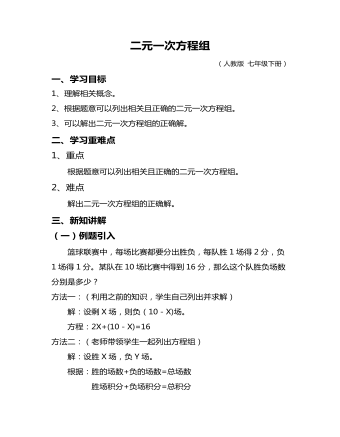
初中数学人教版二元一次方程组教学设计教案
(一)例题引入篮球联赛中,每场比赛都要分出胜负,每队胜1场得2分,负1场得1分。某队在10场比赛中得到16分,那么这个队胜负场数分别是多少?方法一:(利用之前的知识,学生自己列出并求解)解:设剩X场,则负(10-X)场。方程:2X+(10-X)=16方法二:(老师带领学生一起列出方程组)解:设胜X场,负Y场。根据:胜的场数+负的场数=总场数 胜场积分+负场积分=总积分得到:X+Y=10 2X+Y=16

圆的一般方程教学设计人教A版高中数学选择性必修第一册
情境导学前面我们已讨论了圆的标准方程为(x-a)2+(y-b)2=r2,现将其展开可得:x2+y2-2ax-2bx+a2+b2-r2=0.可见,任何一个圆的方程都可以变形x2+y2+Dx+Ey+F=0的形式.请大家思考一下,形如x2+y2+Dx+Ey+F=0的方程表示的曲线是不是圆?下面我们来探讨这一方面的问题.探究新知例如,对于方程x^2+y^2-2x-4y+6=0,对其进行配方,得〖(x-1)〗^2+(〖y-2)〗^2=-1,因为任意一点的坐标 (x,y) 都不满足这个方程,所以这个方程不表示任何图形,所以形如x2+y2+Dx+Ey+F=0的方程不一定能通过恒等变换为圆的标准方程,这表明形如x2+y2+Dx+Ey+F=0的方程不一定是圆的方程.一、圆的一般方程(1)当D2+E2-4F>0时,方程x2+y2+Dx+Ey+F=0表示以(-D/2,-E/2)为圆心,1/2 √(D^2+E^2 "-" 4F)为半径的圆,将方程x2+y2+Dx+Ey+F=0,配方可得〖(x+D/2)〗^2+(〖y+E/2)〗^2=(D^2+E^2-4F)/4(2)当D2+E2-4F=0时,方程x2+y2+Dx+Ey+F=0,表示一个点(-D/2,-E/2)(3)当D2+E2-4F0);

人教版高中数学选修3一元线性回归模型及其应用教学设计
1.确定研究对象,明确哪个是解释变量,哪个是响应变量;2.由经验确定非线性经验回归方程的模型;3.通过变换,将非线性经验回归模型转化为线性经验回归模型;4.按照公式计算经验回归方程中的参数,得到经验回归方程;5.消去新元,得到非线性经验回归方程;6.得出结果后分析残差图是否有异常 .跟踪训练1.一只药用昆虫的产卵数y与一定范围内的温度x有关,现收集了6组观测数据列于表中: 经计算得: 线性回归残差的平方和: ∑_(i=1)^6?〖(y_i-(y_i ) ?)〗^2=236,64,e^8.0605≈3167.其中 分别为观测数据中的温度和产卵数,i=1,2,3,4,5,6.(1)若用线性回归模型拟合,求y关于x的回归方程 (精确到0.1);(2)若用非线性回归模型拟合,求得y关于x回归方程为 且相关指数R2=0.9522. ①试与(1)中的线性回归模型相比较,用R2说明哪种模型的拟合效果更好 ?②用拟合效果好的模型预测温度为35℃时该种药用昆虫的产卵数.(结果取整数).
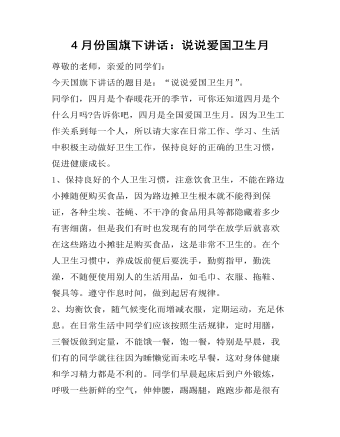
4月份国旗下讲话:说说爱国卫生月
尊敬的老师,亲爱的同学们:今天国旗下讲话的题目是:“说说爱国卫生月”。同学们,四月是个春暖花开的季节,可你还知道四月是个什么月吗?告诉你吧,四月是全国爱国卫生月。因为卫生工作关系到每一个人,所以请大家在日常工作、学习、生活中积极主动做好卫生工作,保持良好的正确的卫生习惯,促进健康成长。1、保持良好的个人卫生习惯,注意饮食卫生,不能在路边小摊随便购买食品,因为路边摊卫生根本就不能得到保证,各种尘埃、苍蝇、不干净的食品用具等都隐藏着多少有害细菌,但是我们有时也发现有的同学在放学后就喜欢在这些路边小摊驻足购买食品,这是非常不卫生的。在个人卫生习惯中,养成饭前便后要洗手,勤剪指甲,勤洗澡,不随便使用别人的生活用品,如毛巾、衣服、拖鞋、餐具等。遵守作息时间,做到起居有规律。2、均衡饮食,随气候变化而增减衣服,定期运动,充足休息。在日常生活中同学们应该按照生活规律,定时用膳,三餐饭做到定量,不能饿一餐,饱一餐,特别是早晨,我们有的同学就往往因为睡懒觉而未吃早餐,这对身体健康和学习精力都是不利的。同学们早晨起床后到户外锻炼,呼吸一些新鲜的空气,伸伸腰,踢踢腿,跑跑步都是很有好处的。
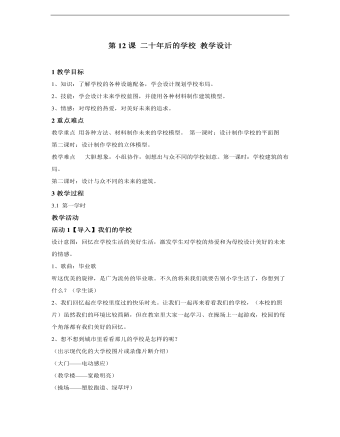
小学美术人教版六年级下册《第12课二十年后的学校》教学设计
2重点难点教学重点用各种方法、材料制作未来的学校模型。第一课时:设计制作学校的平面图第二课时:设计制作学校的立体模型。教学难点大胆想象,小组协作,创想出与众不同的学校创意。第一课时:学校建筑的布局。第二课时:设计与众不同的未来的建筑。3教学过程3.1 第一学时
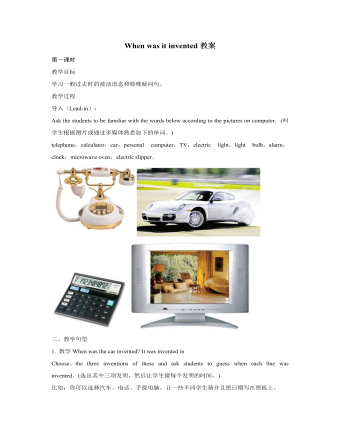
人教版新目标初中英语九年级下册When was it invented教案
二、教学 1a,1b.1.First the teacher asks the students what kind of fruit food and drink you like the best and writes down on the blackboard.教师问学生最喜欢什么水果和饮料并把它们写在黑板上。比如:potato chips,ice cream,tea,lemon,chocolate,oranges,salad,popcorn,pickle and so on.2.接着叫学生表达以上食物的味道,引出新单词——sweet,crispy,salty,sour,delicious,hot,awful,nice…并且完成lb教学内容通过此活动,以旧带新引入新单词。其目的是让学生自主学习新知识。 三、教学 2a,2b1.首先,听力前的brainstormFirst,Let students describe how potato chips taste and describe how helpful the potato chips.Then,ask:When and where were potato chips invented?Who were potato chips invented by?How were potato chips invented?(Let students guess according to the following key words.)Key words:by accident,customer,restaurant,by mistake.(说明:通过问题让学生对对话内容有整体了解,为听力练习做好准备;又培养学生的注意力,想像力,观察力。)
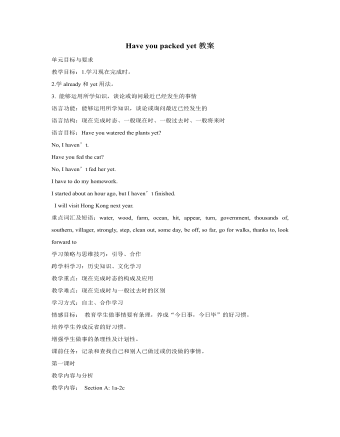
人教版新目标初中英语九年级下册Have you packed yet教案
教学目标:1.学习现在完成时。2.学already和yet用法。3. 能够运用所学知识,谈论或询问最近已经发生的事情语言功能:能够运用所学知识,谈论或询问最近已经发生的语言结构:现在完成时态、一般现在时、一般过去时、一般将来时语言目标:Have you watered the plants yet?No, I haven’t.Have you fed the cat?No, I haven’t fed her yet.I have to do my homework. I started about an hour ago, but I haven’t finished. I will visit Hong Kong next year.重点词汇及短语:water, wood, farm, ocean, hit, appear, turn, government, thousands of, southern, villager, strongly, step, clean out, some day, be off, so far, go for walks, thanks to, look forward to学习策略与思维技巧:引导、合作跨学科学习:历史知识、文化学习教学重点:现在完成时态的构成及应用教学难点:现在完成时与一般过去时的区别 学习方式:自主、合作学习 情感目标: 教育学生做事情要有条理,养成“今日事,今日毕”的好习惯。培养学生养成反省的好习惯。增强学生做事的条理性及计划性。课前任务:记录和查找自己和别人已做过或仍没做的事情。
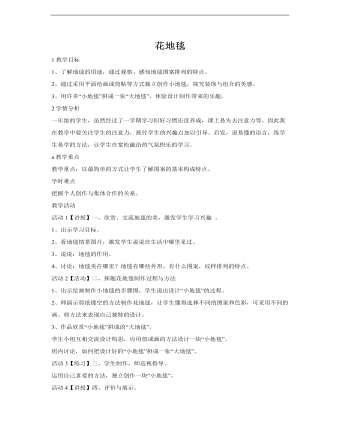
小学美术人教版一年级下册《第3课花地毯》教学设计
2学情分析一年级的学生,虽然经过了一学期学习但好习惯还没养成,课上易失去注意力等。因此我在教学中要关注学生的注意力,抓住学生的兴趣点加以引导、启发,说易懂的语言,练学生易学的方法,让学生在宽松融洽的气氛快乐的学习。a教学重点教学重点:以最简单的方式让学生了解图案的基本构成特点。学时难点把握个人创作与集体合作的关系。
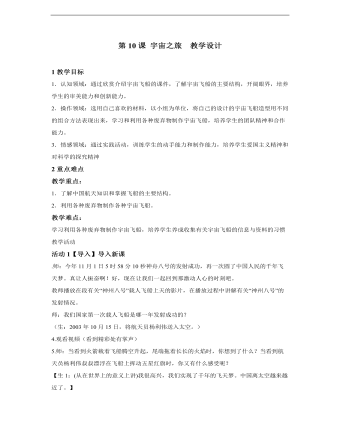
小学美术人教版六年级下册《第10课宇宙之旅》教学设计
2重点难点教学重点:1.了解中国航天知识和掌握飞船的主要结构。2.利用各种废弃物制作各种宇宙飞船。教学难点:学习利用各种废弃物制作宇宙飞船,培养学生养成收集有关宇宙飞船的信息与资料的习惯教学活动活动1【导入】导入新课.师:今年11月1日5时58分10秒神舟八号的发射成功,再一次圆了中国人民的千年飞天梦。真让人振奋啊!好,现在让我们一起回到那激动人心的时刻吧。教师播放在段有关“神州八号”载人飞船上天的影片,在播放过程中讲解有关“神州八号”的发射情况。
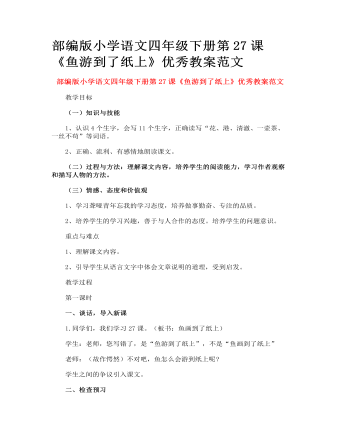
部编版小学语文四年级下册第27课《鱼游到了纸上》优秀教案范文
1.想想课文讲了一件什么事?“鱼游到了纸上”的意思是什么?(“我”去玉泉观鱼,认识了一位残疾青年,他每个星期天都来这里画金鱼。“鱼游到了纸上”意思是说这位青年画的金鱼十分形象生动,像活的那样在纸上游动。学生可以从整体感知课文内容,只要大致说出课文讲了一件什么事就行了。)2.你是怎么知道这位青年是聋哑人?找出课文中的有关语句。(“从来不说一句话”“没有任何反应”,和他胸前佩戴的“福利工厂”的厂徽,可以看出他是一位聋哑青年。如果是会说话的人,不可能从来不说一句话;如果是听得见的人,那么在众人的赞叹、议论声中,不可能“没有任何反应”;“福利工厂”一般是专为残疾人开办的工厂。)
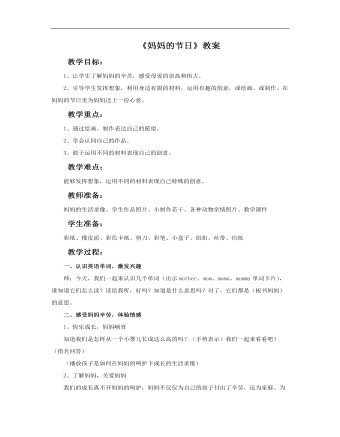
小学美术人教版一年级下册《第12课妈妈的节日》教案
教学重点:1、通过绘画、制作表达自己的愿望。2、学会认同自己的作品。3、敢于运用不同的材料表现自己的创意。教学难点:能够发挥想象,运用不同的材料表现自己特殊的创意。教师准备:妈妈的生活录像、学生作品照片、小制作若干、各种动物亲情照片、教学课件学生准备:彩纸、橡皮泥、彩色卡纸、剪刀、彩笔、小盒子、纽扣、丝带、信纸

人教版新目标初中英语九年级下册By the time I got outside, the bus had already left教案
Ⅰ. Teaching Aims and Demands1. Knowledge Objects(1) Key Vocabularyoversleep(2) Target LanguageWhat happened?I overslept. And by the time I got up, my brother had already gotten in the shower.2. Ability Objects(1) Teach the students to use the new words.(2) Train the students to narrate past events with the Past Perfect Tense.(3) Train the students' listening and speaking skills with the target language.3. Moral ObjectIt’s a good habit to go to bed early in the evening and get up early in the morning. So you’ll never be in a hurry in the morning.Ⅱ. Teaching Key Points1. Key Vocabularyoversleep2. Target LanguageNarrate past events with the Past Perfect TenseⅢ. Teaching Difficult Points1. Train the students to narrate past events with the Past Perfect Tense.2. Train the students to understand the target language in spoken conversation.Ⅳ. Teaching Methods1. Thinking of examples from the students' real lives.2. Making sentences by looking at the pictures.Ⅴ. Teaching AidA tape recorderⅥ. Teaching ProceduresStep I Revision1. Revise the language points in Unit 8.Ask some questions like this: What volunteer work would you like to do?Help the students to answer, I’d like to…/I love to…/I hope to2. Practice the dialogue in Activity 3c on page 62 again. Get students to role play the similar dialogues with the following.

人教版新目标初中英语九年级下册I’ll help clean up the city parks教案
Talk about offering help (P60)I’ll help clean up the city parks.A: I’d like to work ...B: You could help ...Talk about ways to tell people about the Clean-Up Day (P61)We need to ...We can’t ...I’ll ...Talk about the work the volunteers do (P62)These three students all volunteer their time to help other people.Somebody loves to ... / helps ... / plans to ... / wants to ...A: What do you like doing?B: I like ... A: What kind of volunteer work do you think I could do?B: You could ...1. 重点词汇advertisement, fix, repair, pleasure, blind, deaf, shut, carry, specially, fetch2. 认读词汇hunger, homeless, cheer, clean-up, sign, establish, major, commitment, elementary, veterinarian, coach, similar, call-in, strategy, disabled, organization, unable, support, appreciate, donation, part of speech, pronoun, adverb, preposition, conjunction, donate, Jimmy, Sally3. 词组clean up, cheer up, give out, put off, set up, think up, take after, fix up, give away, put up, hand out, work out, at once

人教版新目标初中英语九年级下册Could you please tell me where the restrooms are教案
Step Ⅰ RevisionCheck homework. Ask a few students to read the article in 3a.Then ask a few students to read their guides.Step Ⅱ Part 1Look at the words in the box. Ask a student to read them. Make sure the students understand the meaning of the words. You are to fill in the blanks with the words. In some cases, students may need to use another form of the word, for example adjusting for tense or subject/ verb agreement.Ask students to fill in the blanks on their own.Check the answers. Step ⅢPart 2Go through the instructions with the class.Look at the example with the students.Ask students what the answer would be.Ask a student to read the question and answer it.Excuse me, could you tell me where the bank is, please?The bank is across the street from the shopping malt.Get students to complete the work in pairs.Check the answers. Ask a few students to read their questions.Step Ⅳ Just for Fun!Ask all the students to read the conversation. Ask: What is funny about this cartoon? Help students to explain. A Martian is a person from the planet Mars.There is no such thing as Martian food on Earth, and the clerk looks silly because he is trying to think of where there is a Martian restaurant.Invite some pairs of students to present this conversation to the rest of the class.Step Ⅴ Summary and HomeworkIn this class, we’ve done much writing practice using the key vocabulary words and the target language presented in this unit. After class, please finish the questions in 2 in your exercise books. Then finish the exercises on pages 47~48 of the workbook as well.The Seventh Period Ⅰ Teaching Aims and Demands1. Knowledge Objects(1) Key Vocabularyimage, adventure, jealousy, hero, crime, journey, brave, no longer, show interest in, take it easy, become interested in, plain looks(2)Text:Grown-ups like cartoons, too.2. Ability Objects(1) Fast-reading to get a general idea of the text.(2) Careful-reading to get the detailed information in the text.

人教版新目标初中英语九年级下册We’re trying to save the manatees教案2篇
本单元主要围绕着有关濒临灭绝的动物这一话题,学习了应该怎样保护我们的环境,以及就某一问题展开辩论。目标提示语言目标能够运用所学知识,就某一问题展开辩论。认知目标1、复习一些语法:现在进行时、一般现在时、用used to 表示一般过去时、现在完成时、一般过去时的被动语态。2、学会表达同意和不同意。3、学会以下基本句型:We’re trying to save the manatees.Manatees eat about 100 pounds of food a day.There used to be a lot of manatees.In 1972,it was discovered that they were endangered.Some of the swamps have become polluted.情感目标了解一些濒临灭绝的动物的生活习性和濒临灭绝的原因,教育学生应该如何保护环境。教学提示充分利用多媒体等教学设备,创设与本课话题相关的情境,如各种不同种类的动物、动物园以及有关环境的画画等等。围绕着本单元的教学目标,设计一些贴近学生实际的教学任务,如让学生谈论自己最喜欢的动物,如何拯救濒危动物,如何保护环境等等。让学生根据所学知识,就动物园是否对动物有利以及其他的话题进行辩论。

人教版新目标初中英语九年级下册Rainy days make me sad教案
1. 教材分析本单元以how do things affect you?为话题, 从颜色、天气、音乐、广告、产品等方面谈论了外界事物如何影响人的心情。要求学生掌握表达某物或某事给人带来的感觉、看法或影响等。共设计了四个部分的内容:Section A 该部分有4个模块:第一模块围绕Which restaurant would you like to go to?这一话题展开思维(1a)、听力(1b)、口语(1c)训练;第二模块围绕How does music affect you? 进行听力(2a-2b)、口语训练(2c);第三模块继续围绕how do colors in the restaurant affect you这一话题展开训练,训练形式为阅读和问题体验(3a)和小组活动(3b);第四模块仍就How do things affect you这一话题以调查的形式展开讨论。Section B该部分有4个模块:第一模块围绕产品广告对人们的影响这一话题以“配对”(1a)与“列举”(1b)两种形式展开训练;第二模块继续围绕How do things affect you? 进行听力(2a-2b)、口语对话训练(2c);第三模块围绕“Advertising”这一话题展开阅读(3a-3b)和写作(3c)训练;第四模块围绕How posters affect you这一话题以口语训练形式展开小组活动。

人教版新目标初中英语九年级下册You’re supposed to shake hands教案
教学目标:1. 掌握本单元一些重点词汇的写法和用法。2. 学会自如谈论餐桌礼仪。Step 1 RevisionAsk some students to retell the customs at the table in France in the passage in 3a.Step 2 Self checkPart 1. Fill in each bland with the correct word given. Students do the exercises by themselves at first. Then check the answers. Ask the students to comprehend the sentences and help them point out uses of some words, like “arrive (at / in) sw., spend time / money on sth , spend time / money (in) doing sth.”Part 2. Read about Fan Ling’s experience in a western restaurant. Understand the passage. Point out some key points in the passage.1. be / get used to doing sth. 习惯做某事2. begin with = start with 以….开头3. crowd v. 挤满,塞满 the crowd 人群 crowded adj. 拥挤的Then students discuss about how she would solve her problem. Ask some to share their stories with others.Part 3. Complete the crossword by looking at the sentences on the left. Then check the answers.

人教版高中数学选修3离散型随机变量的方差教学设计
3.下结论.依据均值和方差做出结论.跟踪训练2. A、B两个投资项目的利润率分别为随机变量X1和X2,根据市场分析, X1和X2的分布列分别为X1 2% 8% 12% X2 5% 10%P 0.2 0.5 0.3 P 0.8 0.2求:(1)在A、B两个项目上各投资100万元, Y1和Y2分别表示投资项目A和B所获得的利润,求方差D(Y1)和D(Y2);(2)根据得到的结论,对于投资者有什么建议? 解:(1)题目可知,投资项目A和B所获得的利润Y1和Y2的分布列为:Y1 2 8 12 Y2 5 10P 0.2 0.5 0.3 P 0.8 0.2所以 ;; 解:(2) 由(1)可知 ,说明投资A项目比投资B项目期望收益要高;同时 ,说明投资A项目比投资B项目的实际收益相对于期望收益的平均波动要更大.因此,对于追求稳定的投资者,投资B项目更合适;而对于更看重利润并且愿意为了高利润承担风险的投资者,投资A项目更合适.

人教A版高中数学必修一函数模型的应用教学设计(2)
本节通过一些函数模型的实例,让学生感受建立函数模型的过程和方法,体会函数在数学和其他学科中的广泛应用,进一步认识到函数是描述客观世界变化规律的基本数学模型,能初步运用函数思想解决一些生活中的简单问题。课程目标1.能利用已知函数模型求解实际问题.2.能自建确定性函数模型解决实际问题.数学学科素养1.数学抽象:建立函数模型,把实际应用问题转化为数学问题;2.逻辑推理:通过数据分析,确定合适的函数模型;3.数学运算:解答数学问题,求得结果;4.数据分析:把数学结果转译成具体问题的结论,做出解答;5.数学建模:借助函数模型,利用函数的思想解决现实生活中的实际问题.重点:利用函数模型解决实际问题;难点:数模型的构造与对数据的处理.

